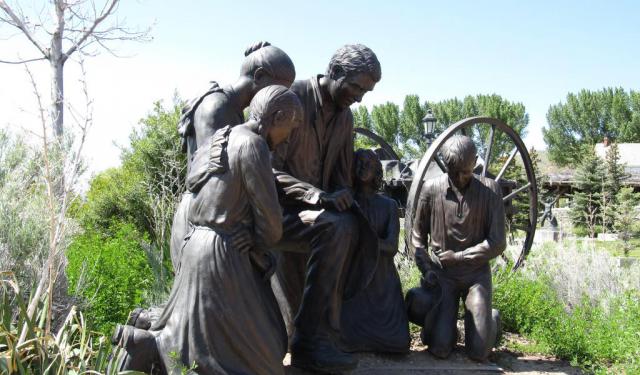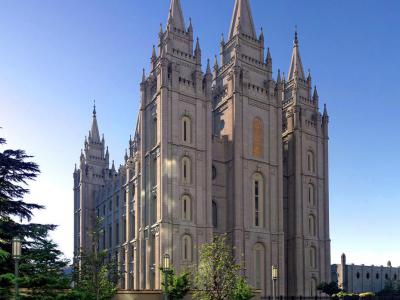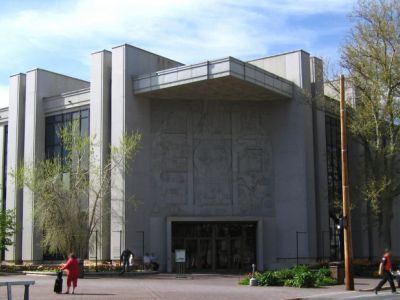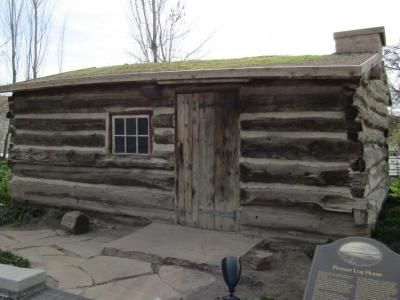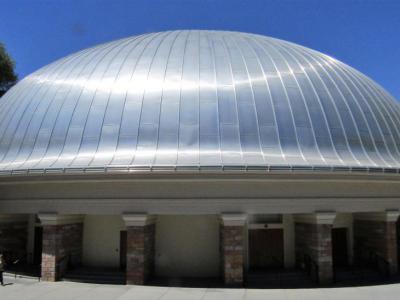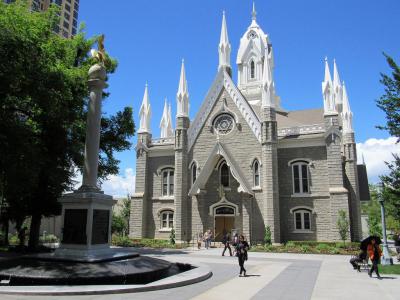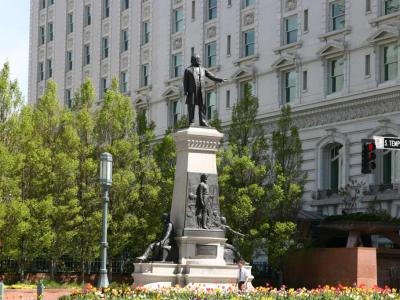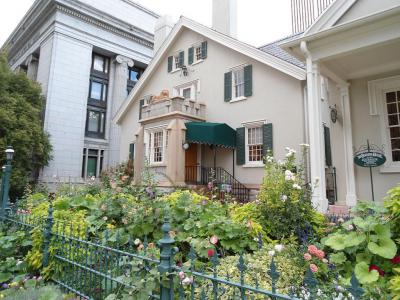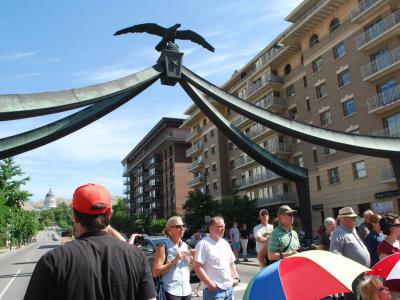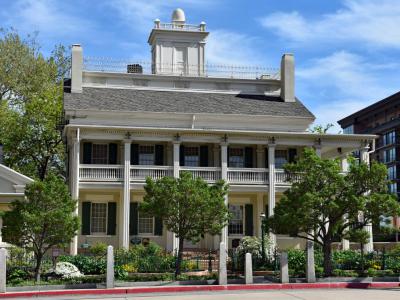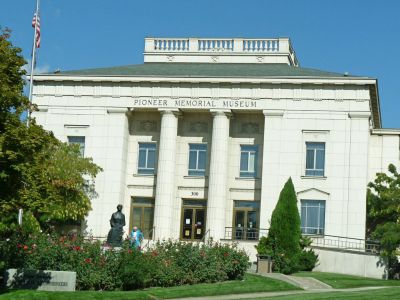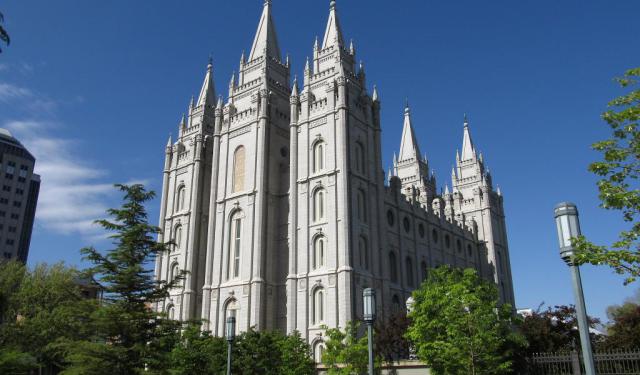Pioneers Trail (Self Guided), Salt Lake City
After extensive religious persecution in the Eastern and Midwestern United States, the Mormon Pioneers made their way westward across the plains and mountains to a spot where Brigham Young said God had designated they should stop and settle. Unlike other social groups (farmers, miners, merchants) who created other western cities, these settlers arrived in Salt Lake Valley as a centrally organized society dedicated to a communal, religious goal: establishing the Kingdom of God on Earth.
An incredibly innovative irrigation system, a food security safety net, a solid dose of cooperation, and a sense of mutualism that bordered on socialism made them succeed against the odds.
At the heart of the Pioneer Trail in Salt Lake City rises the Salt Lake Temple, a symbol of faith and perseverance for the Latter-day Saints (LDS) community. Adjacent to the temple is the Church History Museum, where visitors can delve into the rich history of the LDS Church.
Moving along the trail, one encounters the Deuel Log Cabin, a quaint reminder of the rustic beginnings of Salt Lake City. Nearby stands the Salt Lake Tabernacle and the Salt Lake Assembly Hall, both iconic structures with significant cultural and religious importance.
Further along, visitors come across the Brigham Young Monument, honoring the influential leader of the early Mormon pioneers, and the Meridian Marker, a pivotal point from which all measurements across Utah originate. The trail also features the Lion House and Eagle Gate, notable landmarks reflecting the architectural heritage of the region.
A highlight of the journey is the Beehive House, once the residence of Brigham Young and now a museum offering insights into pioneer life. Finally, the trail culminates at the Pioneer Memorial Museum, where artifacts and exhibits vividly portray the struggles and triumphs of the pioneering era.
Embark on the Pioneer Trail in Salt Lake City to immerse yourself in the rich tapestry of history, culture, and faith that defines this remarkable city. To a history enthusiast, religious pilgrim, or simply a curious traveler, this trail promises a captivating exploration of the past that continues to shape the present. Come and discover the stories of courage, resilience, and vision that resonate along this historic trail.
An incredibly innovative irrigation system, a food security safety net, a solid dose of cooperation, and a sense of mutualism that bordered on socialism made them succeed against the odds.
At the heart of the Pioneer Trail in Salt Lake City rises the Salt Lake Temple, a symbol of faith and perseverance for the Latter-day Saints (LDS) community. Adjacent to the temple is the Church History Museum, where visitors can delve into the rich history of the LDS Church.
Moving along the trail, one encounters the Deuel Log Cabin, a quaint reminder of the rustic beginnings of Salt Lake City. Nearby stands the Salt Lake Tabernacle and the Salt Lake Assembly Hall, both iconic structures with significant cultural and religious importance.
Further along, visitors come across the Brigham Young Monument, honoring the influential leader of the early Mormon pioneers, and the Meridian Marker, a pivotal point from which all measurements across Utah originate. The trail also features the Lion House and Eagle Gate, notable landmarks reflecting the architectural heritage of the region.
A highlight of the journey is the Beehive House, once the residence of Brigham Young and now a museum offering insights into pioneer life. Finally, the trail culminates at the Pioneer Memorial Museum, where artifacts and exhibits vividly portray the struggles and triumphs of the pioneering era.
Embark on the Pioneer Trail in Salt Lake City to immerse yourself in the rich tapestry of history, culture, and faith that defines this remarkable city. To a history enthusiast, religious pilgrim, or simply a curious traveler, this trail promises a captivating exploration of the past that continues to shape the present. Come and discover the stories of courage, resilience, and vision that resonate along this historic trail.
How it works: Download the app "GPSmyCity: Walks in 1K+ Cities" from Apple App Store or Google Play Store to your mobile phone or tablet. The app turns your mobile device into a personal tour guide and its built-in GPS navigation functions guide you from one tour stop to next. The app works offline, so no data plan is needed when traveling abroad.
Pioneers Trail Map
Guide Name: Pioneers Trail
Guide Location: USA » Salt Lake City (See other walking tours in Salt Lake City)
Guide Type: Self-guided Walking Tour (Sightseeing)
# of Attractions: 10
Tour Duration: 1 Hour(s)
Travel Distance: 1.9 Km or 1.2 Miles
Author: tamara
Sight(s) Featured in This Guide:
Guide Location: USA » Salt Lake City (See other walking tours in Salt Lake City)
Guide Type: Self-guided Walking Tour (Sightseeing)
# of Attractions: 10
Tour Duration: 1 Hour(s)
Travel Distance: 1.9 Km or 1.2 Miles
Author: tamara
Sight(s) Featured in This Guide:
- Salt Lake Temple
- Church History Museum
- Deuel Log Cabin
- Salt Lake Tabernacle
- Salt Lake Assembly Hall
- Brigham Young Monument / Meridian Marker
- Lion House
- Eagle Gate
- Beehive House
- Pioneer Memorial Museum
1) Salt Lake Temple (must see)
The centerpiece of Temple Square, this beautiful neo-gothic edifice took 40 years to build at the direction of then Church President, Brigham Young, and has withstood the test of time since being dedicated in 1893. The granite-like quartz monzonite was quarried in Little Cottonwood Canyon, 22 miles south of the site, and was then laboriously hauled by oxen, stone by stone, until the railroad became operational in 1869. Oriented towards Jerusalem and incorporating a host of symbolic designs and decorations, many of which are visible on the exterior, it remains the largest LDS temple by floor area (253,015 square feet / 23,505.9 square meters). Its massive presence is a marvel, considering there was no electricity, no computers, nor any other artificial means used during construction. The stone masonry is so precise, there is not even mortar between the stones! And then to think the pioneers built this huge edifice in the middle of a desert guided by faith is just awesome.
As with all LDS temples, only qualifying members of the LDS faith can enter the building (used primarily for marriages, baptisms for the dead, religious ritual instruction, and meetings of the First Presidency and of the Quorum of the Twelve Apostles), but visitors can walk around the exterior and enter other historic structures nearby. During the winter months the beauties of the world-famous flower beds are replaced by nativity displays and millions of Christmas lights strung through all the trees on Temple Square, making it a hugely popular destination for visitors and locals alike.
***PIONEERS TRAIL***
As noted by the scholars, "Brigham Young was almost sole author of one of the most important chapters in the history of the American West." When the first group of pioneers, led by Young, entered Immigration Canyon overlooking the Salt Lake Valley on July 24, 1847, Young (who had been ill and was bedded in a covered wagon) rose long enough to gaze out over the valley and famously declared "This is the right place. Drive on." Those with him clearly understood that he was talking about his vision of where the Latter-Day Saints were to settle. It should be noted that Church leaders and members alike felt that settling in Utah (near the Rockies) would fulfill Isaiah 2:2 - "And it shall come to pass in the last days, that the mountain of the LORD'S house [temple] shall be established in the top of the mountains, and shall be exalted above the hills; and all nations shall flow unto it."
Perhaps among Young's greatest visible accomplishments was his initiation of the construction of the world famous Salt Lake Temple and Tabernacle on Temple Square, and the incredible construction of a system of miles and miles of irrigation canals that fulfilled the prophecy in Isaiah 35:1 "The wilderness and the solitary place shall be glad for them; and the desert shall rejoice, and blossom as the rose."
Tip:
One of the best (and free!) views of the edifice (and of Temple Square) is from the atrium and inside of The Roof restaurant, located on the top floor of the Joseph Smith Memorial Building, a short walk and elevator ride directly to the east.
As with all LDS temples, only qualifying members of the LDS faith can enter the building (used primarily for marriages, baptisms for the dead, religious ritual instruction, and meetings of the First Presidency and of the Quorum of the Twelve Apostles), but visitors can walk around the exterior and enter other historic structures nearby. During the winter months the beauties of the world-famous flower beds are replaced by nativity displays and millions of Christmas lights strung through all the trees on Temple Square, making it a hugely popular destination for visitors and locals alike.
***PIONEERS TRAIL***
As noted by the scholars, "Brigham Young was almost sole author of one of the most important chapters in the history of the American West." When the first group of pioneers, led by Young, entered Immigration Canyon overlooking the Salt Lake Valley on July 24, 1847, Young (who had been ill and was bedded in a covered wagon) rose long enough to gaze out over the valley and famously declared "This is the right place. Drive on." Those with him clearly understood that he was talking about his vision of where the Latter-Day Saints were to settle. It should be noted that Church leaders and members alike felt that settling in Utah (near the Rockies) would fulfill Isaiah 2:2 - "And it shall come to pass in the last days, that the mountain of the LORD'S house [temple] shall be established in the top of the mountains, and shall be exalted above the hills; and all nations shall flow unto it."
Perhaps among Young's greatest visible accomplishments was his initiation of the construction of the world famous Salt Lake Temple and Tabernacle on Temple Square, and the incredible construction of a system of miles and miles of irrigation canals that fulfilled the prophecy in Isaiah 35:1 "The wilderness and the solitary place shall be glad for them; and the desert shall rejoice, and blossom as the rose."
Tip:
One of the best (and free!) views of the edifice (and of Temple Square) is from the atrium and inside of The Roof restaurant, located on the top floor of the Joseph Smith Memorial Building, a short walk and elevator ride directly to the east.
2) Church History Museum
A church that makes a priority of remembering their history are going to have lots of items that are held in reverence. The Church History Museum contains many relics of this past, any of which may hold some specific regard by a given person: a chisel that helped shape the stone of the Temple, for instance; the printing press that produced the first edition of the Book of Mormon in 1830, or a chair that carpenter Brigham Young built before joining the LDS Church in 1832.
On the first floor, exhibits cover in detail the founders' lives and visions, the persecutions and the eventual settlement in Utah. Docents greet visitors in different areas and offer short insights on a topic while respecting the decision to engage or wander on one's own. The 2nd floor explores the lives of past prophets through personal artifacts and multi-media displays, while a new exhibit titled "Temples Dot the Earth", though specially designed for children, is informative for all ages.
There are also several halls of religious artwork and, before leaving the museum, don't forget to stop at the lovely gift shop for beautiful Salt Lake Temple ornaments, greeting cards by Utah artists, and many more quality items.
Why You Should Visit:
Incredibly well done with loads of interactive features, this museum offers excellent insights into pioneer history and the LDS Church.
On the first floor, exhibits cover in detail the founders' lives and visions, the persecutions and the eventual settlement in Utah. Docents greet visitors in different areas and offer short insights on a topic while respecting the decision to engage or wander on one's own. The 2nd floor explores the lives of past prophets through personal artifacts and multi-media displays, while a new exhibit titled "Temples Dot the Earth", though specially designed for children, is informative for all ages.
There are also several halls of religious artwork and, before leaving the museum, don't forget to stop at the lovely gift shop for beautiful Salt Lake Temple ornaments, greeting cards by Utah artists, and many more quality items.
Why You Should Visit:
Incredibly well done with loads of interactive features, this museum offers excellent insights into pioneer history and the LDS Church.
3) Deuel Log Cabin
The Deuel Log Cabin in Salt Lake City is a remarkable remnant of early Mormon pioneer history, nestled discreetly between the Museum of Church History and the Family History Library, just across from Temple Square. Built in 1847, this cabin stands as one of only two surviving original log homes constructed by the Mormon settlers upon their arrival in the Salt Lake Valley. The Deuel cabin preserves its authentic roof, walls, and supporting beams-materials that have endured for over 170 years.
Originally home to Osmyn and Mary Deuel along with Osmyn’s brother Amos, the cabin measures a compact 15 by 20 feet, offering a rare glimpse into the modest pioneer lifestyle through a plexiglass viewing door. Restored to reflect its 1847 condition, it is furnished with period artifacts, illustrating the practical yet sparse living arrangements typical of the time.
The structure has journeyed across several locations before reaching its current setting in 1985. Initially part of the Old Fort at Pioneer Park, it later moved to Temple Square as a preserved historic artifact. Since its restoration, the cabin has been surrounded by landscaping that features native Utah plants, curated to evoke the environment the Deuels would have known.
This cabin is not only a preserved piece of architecture but a tangible connection to the lives of the Deuel family and other early pioneers, capturing a significant moment in the settlement of the Salt Lake Valley. Its enduring presence offers visitors a quiet, reflective space amid Temple Square's bustling surroundings, inviting them to step briefly into Utah’s pioneer past.
Originally home to Osmyn and Mary Deuel along with Osmyn’s brother Amos, the cabin measures a compact 15 by 20 feet, offering a rare glimpse into the modest pioneer lifestyle through a plexiglass viewing door. Restored to reflect its 1847 condition, it is furnished with period artifacts, illustrating the practical yet sparse living arrangements typical of the time.
The structure has journeyed across several locations before reaching its current setting in 1985. Initially part of the Old Fort at Pioneer Park, it later moved to Temple Square as a preserved historic artifact. Since its restoration, the cabin has been surrounded by landscaping that features native Utah plants, curated to evoke the environment the Deuels would have known.
This cabin is not only a preserved piece of architecture but a tangible connection to the lives of the Deuel family and other early pioneers, capturing a significant moment in the settlement of the Salt Lake Valley. Its enduring presence offers visitors a quiet, reflective space amid Temple Square's bustling surroundings, inviting them to step briefly into Utah’s pioneer past.
4) Salt Lake Tabernacle (must see)
A great marvel of sound and acoustics, this domed building is the home of the famed Tabernacle Choir, and was the previous home of the Utah Symphony Orchestra until the construction of Abravanel Hall. Inside, the beautiful pipe organ – one of the largest in the world – is something to see, but catching a Sunday morning choir performance (or a rehearsal at the least – Thursdays at 7:30pm) counts as one of those experiences of a life time. Both the tour and the choir concerts/rehearsals are free to the public, by the way!
At a time before electronics and audio amplifiers, the Tabernacle was constructed with remarkable acoustic qualities so the entire congregation could hear sermons given here. The roof was built in a three-dimensional ellipse – a concept that came from none other than church president Brigham Young, who reportedly said that the design was inspired by "the best sounding board in the world ... the roof of my mouth." It is common for LDS missionary tour guides to demonstrate the acoustics by dropping a pin on the pulpit or tearing a newspaper there, which can be heard throughout the building.
Built without nails, the structure itself was an architectural wonder in its day, prompting a writer for Scientific American to comment on "the mechanical difficulties of attending the construction of so ponderous a roof." Apparently, the supporting beams were made by a shipbuilder, who used his knowledge to hold together the dome by means of horsehair and leather alone. In 1882, while on a lecture tour of America, Oscar Wilde noted that the building had the appearance of a soup-kettle; he added that it was the most purely dreadful building he ever saw. Some visitors around the beginning of the 20th century criticized it as "a prodigious tortoise that has lost its way" or "the Church of the Holy Turtle," but Frank Lloyd Wright dubbed the Tabernacle "one of the architectural masterpieces of the country and perhaps the world."
At a time before electronics and audio amplifiers, the Tabernacle was constructed with remarkable acoustic qualities so the entire congregation could hear sermons given here. The roof was built in a three-dimensional ellipse – a concept that came from none other than church president Brigham Young, who reportedly said that the design was inspired by "the best sounding board in the world ... the roof of my mouth." It is common for LDS missionary tour guides to demonstrate the acoustics by dropping a pin on the pulpit or tearing a newspaper there, which can be heard throughout the building.
Built without nails, the structure itself was an architectural wonder in its day, prompting a writer for Scientific American to comment on "the mechanical difficulties of attending the construction of so ponderous a roof." Apparently, the supporting beams were made by a shipbuilder, who used his knowledge to hold together the dome by means of horsehair and leather alone. In 1882, while on a lecture tour of America, Oscar Wilde noted that the building had the appearance of a soup-kettle; he added that it was the most purely dreadful building he ever saw. Some visitors around the beginning of the 20th century criticized it as "a prodigious tortoise that has lost its way" or "the Church of the Holy Turtle," but Frank Lloyd Wright dubbed the Tabernacle "one of the architectural masterpieces of the country and perhaps the world."
5) Salt Lake Assembly Hall
Yet another interesting place in Temple Square, this early meeting hall for members of the LDS Church is currently one of two religious buildings that non-LDS members can freely access. Although built of quartz monzonite rock from the same quarry as the Salt Lake Temple, the Assembly Hall's unhewn exterior looks much different, due to its stones having not been as exactingly cut. This accounts for the building's dark, rough texture which, together with the cruciform layout and the stained-glass windows, gives it the appearance of a small gothic cathedral.
However, the deceptively Gothic exterior conceals a more modern interior lacking vaulted ceilings. Details of the woodwork are beautiful, and there is an elegant organ (albeit smaller than the one in the Conference Center or the Tabernacle next door) centered up front. The acoustics don't rival the world-famous Tabernacle, but they are still quite impressive – and so are the performers. Walk in right before a concert and you'll be graciously allowed to stay and listen.
***PIONEERS TRAIL***
Directly east of the Assembly Hall stands the Seagull Monument, erected to commemorate the so-called "miracle of the gulls", in which, following fervent prayers, legions of native seagulls suddenly appeared and started devouring the swarm of crickets that was destroying much-needed crops during the pioneer farmers' first spring season in Utah. It is said that these birds, native to the Great Salt Lake, ate mass quantities of crickets, drank some water, regurgitated, and continued eating the pests over a two-week period. The pioneers saw the gulls' arrival as a miracle, and the story was recounted from the pulpit by church leaders such decades after the event.
However, the deceptively Gothic exterior conceals a more modern interior lacking vaulted ceilings. Details of the woodwork are beautiful, and there is an elegant organ (albeit smaller than the one in the Conference Center or the Tabernacle next door) centered up front. The acoustics don't rival the world-famous Tabernacle, but they are still quite impressive – and so are the performers. Walk in right before a concert and you'll be graciously allowed to stay and listen.
***PIONEERS TRAIL***
Directly east of the Assembly Hall stands the Seagull Monument, erected to commemorate the so-called "miracle of the gulls", in which, following fervent prayers, legions of native seagulls suddenly appeared and started devouring the swarm of crickets that was destroying much-needed crops during the pioneer farmers' first spring season in Utah. It is said that these birds, native to the Great Salt Lake, ate mass quantities of crickets, drank some water, regurgitated, and continued eating the pests over a two-week period. The pioneers saw the gulls' arrival as a miracle, and the story was recounted from the pulpit by church leaders such decades after the event.
6) Brigham Young Monument / Meridian Marker
First displayed at the Chicago World's Fair in 1893, this 25-foot bronze monument was erected in honor of pioneer-colonizer, Utah governor, and LDS Church president Brigham Young who led the Mormon pioneers into the Utah Territory in 1847 – here seen pointing with an outstretched left arm. Its base has the figure of an Indian facing east and that of a bearded fur trapper facing west, both of which preceded the Mormon settlers. On the south side is a bronze bas-relief of a pioneer man, woman, and child, while another bronze plaque has a list of the pioneers who arrived in the Salt Lake Valley on July 24, 1847, and their equipment.
Redesigned and restored in 2000, the beautifully kept Memorial Gardens also hold the grave of Brigham Young (back left corner with the fencing around it) and of some of his family members, including four of his wives. Just west of the statue, right next to the wall around Temple Square, the Meridian Marker is the spot from where all the measurements in Utah originate. Nothing but a small concrete obelisk, with a medallion on the top, but would make quite a nice spot for geogachers to log a trophy.
Redesigned and restored in 2000, the beautifully kept Memorial Gardens also hold the grave of Brigham Young (back left corner with the fencing around it) and of some of his family members, including four of his wives. Just west of the statue, right next to the wall around Temple Square, the Meridian Marker is the spot from where all the measurements in Utah originate. Nothing but a small concrete obelisk, with a medallion on the top, but would make quite a nice spot for geogachers to log a trophy.
7) Lion House
Taking its name from the recumbent lion set on top of the front portico, this house was constructed 1855-56 as a residence for some of Mormon leader Brigham Young's wives and children. Like all other buildings on Temple Square, it has been pristinely preserved, looking like it was built last year. There is now a pleasant cafeteria-style restaurant inside serving local fare to the faithful and the visitors alike. When you see people gathering together to enter, you know you're in for a good lunch – and you likely won't be disappointed. The homemade bread rolls served with honey butter are Utah famous!
Back in the day, the basement contained a dining room which could accommodate 70 people, while on the main floor were sitting rooms and bedrooms for wives with children. The 2nd floor contained 20 bedrooms for children and childless wives – one under each of the steeply-pitched gables. A polygamist, Young ultimately fathered 57 children by more than two dozen wives, and also had many adopted, foster, and stepchildren. By the 1930s, however, the practice of polygamy had been abandoned by the LDS Church and banned by the state of Utah, making it punishable by imprisonment and a hefty fine.
Back in the day, the basement contained a dining room which could accommodate 70 people, while on the main floor were sitting rooms and bedrooms for wives with children. The 2nd floor contained 20 bedrooms for children and childless wives – one under each of the steeply-pitched gables. A polygamist, Young ultimately fathered 57 children by more than two dozen wives, and also had many adopted, foster, and stepchildren. By the 1930s, however, the practice of polygamy had been abandoned by the LDS Church and banned by the state of Utah, making it punishable by imprisonment and a hefty fine.
8) Eagle Gate
The Eagle Gate in Salt Lake City is a historical monument that spans State Street at the intersection with South Temple, right in the heart of the city’s downtown area. This prominent arch was originally constructed in 1859 as an entrance to Brigham Young’s estate and served as the gateway to City Creek Canyon. With its iconic eagle and beehive sculpture, the monument has come to symbolize Salt Lake City's pioneer heritage and the industrious spirit of Utah.
The gate’s current iteration, designed in the 1960s, is a striking example of Mid-century modern architecture. Supported by four pillars with a steel frame covered in metal panels, the arch leads up to a keystone embellished with five-point stars. Atop this keystone rests a bronze eagle, a replica of the original wooden sculpture that once adorned the gate. This eagle, with a wingspan of 20 feet, is perched on a beehive-a symbolic nod to Utah’s nickname, “The Beehive State.” This enduring symbol of thrift and perseverance has been a part of Utah’s identity since the Mormon pioneer era when the beehive became an emblem of the early settlers’ industrious nature.
On the eastern side of the monument, a granite stone containing a time capsule lies between two pillars, accompanied by a plaque detailing the Eagle Gate’s history. Originally, the gate featured large wooden doors, which were closed nightly to secure Brigham Young’s extensive estate, including the Beehive House, Lion House, private offices, gardens, and various facilities. In 1891, the wooden gates were removed, and the entrance was expanded into a public street, with the eagle receiving a copper-plated finish on stone pillars. By 1960, after the original wood had deteriorated, the gate was rebuilt with an enlarged bronze eagle, solidifying its place as a tribute to the pioneers who established the state.
Today, the Eagle Gate remains one of Salt Lake City’s best-known landmarks, inspiring the names of several local businesses and buildings. As a monument to both historical roots and modern design, it continues to bridge the city’s pioneer legacy with its evolving urban identity.
The gate’s current iteration, designed in the 1960s, is a striking example of Mid-century modern architecture. Supported by four pillars with a steel frame covered in metal panels, the arch leads up to a keystone embellished with five-point stars. Atop this keystone rests a bronze eagle, a replica of the original wooden sculpture that once adorned the gate. This eagle, with a wingspan of 20 feet, is perched on a beehive-a symbolic nod to Utah’s nickname, “The Beehive State.” This enduring symbol of thrift and perseverance has been a part of Utah’s identity since the Mormon pioneer era when the beehive became an emblem of the early settlers’ industrious nature.
On the eastern side of the monument, a granite stone containing a time capsule lies between two pillars, accompanied by a plaque detailing the Eagle Gate’s history. Originally, the gate featured large wooden doors, which were closed nightly to secure Brigham Young’s extensive estate, including the Beehive House, Lion House, private offices, gardens, and various facilities. In 1891, the wooden gates were removed, and the entrance was expanded into a public street, with the eagle receiving a copper-plated finish on stone pillars. By 1960, after the original wood had deteriorated, the gate was rebuilt with an enlarged bronze eagle, solidifying its place as a tribute to the pioneers who established the state.
Today, the Eagle Gate remains one of Salt Lake City’s best-known landmarks, inspiring the names of several local businesses and buildings. As a monument to both historical roots and modern design, it continues to bridge the city’s pioneer legacy with its evolving urban identity.
9) Beehive House
Getting its name from the clearly visible beehive sculpture on top, this was one of two official residences of Brigham Young, who led the famous Mormon migration from Nauvoo, IL, to the Salt Lake Valley in 1847 and became the 2nd president (after founder Joseph Smith) of The Church of Jesus Christ of Latter-Day Saints. Like most buildings on Temple Square, the house is meticulously maintained and can be visited on a free 30-minute tour that takes you around the lower and 2nd floor. Featuring superb woodwork and craftsmanship throughout, the tour provides an excellent opportunity to dig into local history – so if you love old houses and learning about how people lived in times past, this is for you!
Constructed of adobe and sandstone, the home was designed by Young's brother-in-law and architect of the Salt Lake Temple, Truman O. Angell, who also designed the neighboring Lion House – once a home many of his wives and children. Although perhaps an over-achiever in "raising up seed", Young was nonetheless devoted to his first wife above all, as anyone who visits both the Beehive House and the Lion House can attest.
Constructed of adobe and sandstone, the home was designed by Young's brother-in-law and architect of the Salt Lake Temple, Truman O. Angell, who also designed the neighboring Lion House – once a home many of his wives and children. Although perhaps an over-achiever in "raising up seed", Young was nonetheless devoted to his first wife above all, as anyone who visits both the Beehive House and the Lion House can attest.
10) Pioneer Memorial Museum
Step back into the past at this museum dedicated to Utah pioneers, boasting "the world's largest collection of artifacts on one particular subject". The entirety of the building houses the everyday items that Mormon settlers brought with them and used – everything from teacups to sewing machines to eyeglasses to children's toys. Although most of the items are commonplace, some are quite a treat to see, such as a restored steam engine from the American Fire Engine Company or the dresses and doll collections. Some of the displays are truly bizarre, including a collection of rattlesnake rattles, a petrified potato, a two-headed lamb, Victorian hair art and a "bloodstone" that Mormon leader Brigham Young believed to be endowed with magical properties. In addition, you may find wonderful maps of the original Salt Lake Valley settlement, as well as a cool replica of the golden spike that marked the completion of the First Transcontinental Railroad.
The museum does not seem that large, but it will take a while to make your way through due to the sheer volume of things to look at. The staff is made up of friendly volunteers that will offer a map to help with orientation. At a bare minimum, it will take around half an hour to walk through all of the floors and quickly glance through them, though you can easily spend an hour or more. No detail is left unturned on anything at all, with dozens of examples each time.
The Pioneer Memorial Museum is a nice spot to soak in some Utah history effortlessly by sight alone!
The museum does not seem that large, but it will take a while to make your way through due to the sheer volume of things to look at. The staff is made up of friendly volunteers that will offer a map to help with orientation. At a bare minimum, it will take around half an hour to walk through all of the floors and quickly glance through them, though you can easily spend an hour or more. No detail is left unturned on anything at all, with dozens of examples each time.
The Pioneer Memorial Museum is a nice spot to soak in some Utah history effortlessly by sight alone!
Walking Tours in Salt Lake City, Utah
Create Your Own Walk in Salt Lake City
Creating your own self-guided walk in Salt Lake City is easy and fun. Choose the city attractions that you want to see and a walk route map will be created just for you. You can even set your hotel as the start point of the walk.
Historical Buildings Tour
Salt Lake City’s downtown is a good place to view historical buildings and sites, each with its unique story and significance, that reflect the city’s Mormon heritage and more.
One such edifice is the Devereaux Mansion, a stunning example of Second Empire architecture that stands as a testament to the city's prosperous past. The Salt Lake Temple, an iconic symbol of the city and a... view more
Tour Duration: 2 Hour(s)
Travel Distance: 4.0 Km or 2.5 Miles
One such edifice is the Devereaux Mansion, a stunning example of Second Empire architecture that stands as a testament to the city's prosperous past. The Salt Lake Temple, an iconic symbol of the city and a... view more
Tour Duration: 2 Hour(s)
Travel Distance: 4.0 Km or 2.5 Miles
Salt Lake City Downtown Walk
Salt Lake City's downtown epitomizes the city's settlement and growth. Renowned for its cleanliness, visitors often praise its meticulously planned layout, reminiscent of a Cartesian graph centered around Temple Square, a sacred site for members of The Church of Jesus Christ of Latter-day Saints (LDS).
In 1847, Brigham Young, leader of Mormon pioneer settlers, designated the site for... view more
Tour Duration: 2 Hour(s)
Travel Distance: 3.1 Km or 1.9 Miles
In 1847, Brigham Young, leader of Mormon pioneer settlers, designated the site for... view more
Tour Duration: 2 Hour(s)
Travel Distance: 3.1 Km or 1.9 Miles
The Most Popular Cities
/ view all
